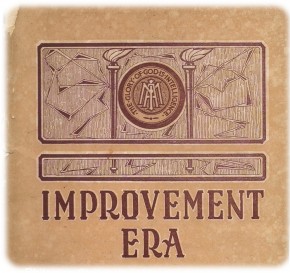The following was adapted from the Improvement Era magazine of 100 years ago.
In the spring of 1894, Elder Squires was serving as a missionary in Leipsic, Germany. He welcomed a new companion, fresh to the mission field, and showed him around the city. After touring the great market-hall and the library, they went to the art gallery.
On the inside the pictures had been placed in a series of rooms each connected with the other in such a way that you may pass from the first room into the next, and so on through all of the others and back again to the first. The new elder—I will call him Elder Green—did not know that they could thus move from room to room, and at last return to their starting place.
 The walls of the different rooms were crowded with the master-pieces of German and Italian artists. In one room was a life-sized portrait of Napoleon which Elder Green admired very much.
The walls of the different rooms were crowded with the master-pieces of German and Italian artists. In one room was a life-sized portrait of Napoleon which Elder Green admired very much.
They passed on around through the different rooms, chatting and admiring the paintings, as they went, and had returned to the portrait of Napoleon.
“My goodness!” exclaimed Elder Green, “there is another portrait of Napoleon!”
Elder Green was not aware that they were on their second trip around. Elder Squires quickly led him from the portrait—he was curious to see how far he could lead Elder Green—before he discovered that he was looking at pictures for the second time. He kept up his interest until they returned again to Napoleon. “Well, well, another picture of Napoleon!” he exclaimed, as he viewed the great warrior for the third time.
They left the gallery. Elder Green had not discovered that he had seen all of the pictures twice, and some of them three times. As they walked away Elder Green wondered that the Leipsic gallery contained such a vast number of fine paintings, so many more than he had seen in the art gallery in London.
Elder Squires told him he had not yet seen the London gallery, and did not know how it compared with the gallery in Leipsic, but he ventured the assertion to Elder Green that London could not produce so many fine portraits of Napoleon.
Elder Squires never told his companion how he had led him around. The new elder had such confidence in him that he hated to let him know how he had played upon his confidence.
Leading You Around The Gallery
Do you have an acquaintance showing you how much greater and better and grander your opportunities for advancement, work and progress will be if you leave your good home and people to go there or yonder?—beware lest he is leading you around the gallery!
Have you a friend who tells you that the people of the world are so much freer than you are, and that your religion tends to make you narrow and one-sided, and then invites you to come out into the open and see the big world?—take heed that he does not lead you around the gallery!
Have you a so-called friend who tells you of the pleasure and freedom and manliness you may gain in the club room, at the gaming-table, in the saloon, in the pool-room, with up-to-date companions, as compared to the hum-drum of home and school, and the Church ward organizations?—set it down, he is leading you around the gallery! Every time, too, that you express surprise at a new Napoleon, he laughs in his sleeve at your ignorance and credulity.
Adapted from: Edward H. Anderson, “For the Development of Character”, Improvement Era, Vol. XIV. January, 1911. No. 3.

stilistically very well built-on article! especially the part below with the questions appeal at the reader, so really thanks for the comment which I like a lot!